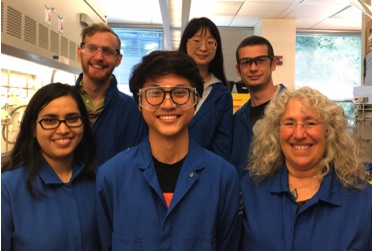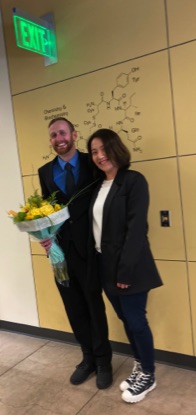Dr. Patrick Skelly
Thesis abstract:
Polyvinyl Chloride (PVC) is the third most-produced plastic in the world. It is found in construction materials, pipes that contain our drinking water, toys, furniture, clothing, credit cards, medical tubing and blood bags. Because of the sheer quantity of PVC in the world, it is important to make it as safe as possible. Health concerns over additives to PVC can add up over a lifetime of exposure to household products. Environmental concerns over the degradation of PVC also add up with millions of tons entering the waste stream every year.
This dissertation addresses two aspects of chemical modification of PVC with regards to these health and environmental concerns. The first aspect is the internal plasticization of PVC, replacing migratory plasticizers that can enter the body. The second is controlled chemical degradation of PVC, working towards the goal of harvesting PVC waste as a carbon resource.
The first chapter is a review article about internal plasticization: covalently bonding plasticizers to PVC. A comprehensive review of this field was previously lacking. Literature from 1936 to 2021 is reviewed and categorized by method of attachment, either nucleophilic substitution or graft-from polymerization. A perspective is given on the types of structures and syntheses used in successful internal plasticizers.
With the continued goal of internal plasticization, the second chapter is an experimental study of the metal-free azide-alkyne cycloaddition, a reaction well-suited for attaching plasticizers to PVC. To more effectively use this reaction, the effect of different electron-withdrawing groups was studied. A range of alkynes were synthesized and their rates compared by competition experiments. The most reactive alkyne contained a sulfone group and an ester group, and reacted 2100 times faster than the least reactive, containing a phenyl substituent and an ester. Phenyl- and nitrophenyl- substituents surprisingly decreased the reactivity of the alkynes instead of increasing it. DFT calculations of reaction energies, orbital energies, distortion-interaction parameters, and bond indices were performed to help explain the reactivity trends.
The third chapter addresses the chemical degradation of PVC. A method was developed to eliminate chloride from PVC using hydroxide base, and then cleave the all-carbon backbone using olefin metathesis of the newly-created double bonds. Addition of allyl alcohol to the elimination step allows the incorporation of allyl side chains, which more easily attach to the metathesis catalyst and incorporate it into the main chain by a ring-closing metathesis reaction. Over 20x reduction in molecular weight is observed, demonstrating repeated cleavage of the polymer chain. By adding an external alkene to the reaction, a diene with the corresponding substituents is successfully created, indicating some incorporation of PVC carbons into a new chemical product.
Ph.D. 2023: “Chemical Modification of Polyvinyl Chloride: Plasticization and Chemical Degradation"
• Bachelor of Science: Colorado School of Mines, 2016
Publications with the Braslau Group:
1. Patrick W. Skelly, Chayo Fuentes Chang, Rebecca Braslau,* “Degradation of Polyvinyl Chloride by Sequential Dehydrochlorination and Olefin Metathesis,” ChemPlusChem, 2023, 88, e20230018. DOI: 10.1002/cplu.202300184
2. Patrick W. Skelly, Longbo Li, Rebecca Braslau,* Internal Plasticization of PVC, Polymer Reviews, 2022, 62, 485-528. DOI: 10.1080/15583724.2021.1986066
3. Patrick W. Skelly, Jirapon Sae-Jew, Ana Paula Kitos Vasconcelos, Jerin Tasnim, Longbo Li, Jevgenij Raskatov, and Rebecca Braslau,* “Relative Rates of Metal-Free Azide-Alkyne Cycloadditions: Tunability over Three Orders of Magnitude,” Journal of Organic Chemistry, 2019, 84, 13615-13623.
4. Wiley Schultz-Simonton, Patrick Skelly, Indranil Chakraborty, Pradip Mascharak, and Rebecca Braslau* "Synthesis, Structure, and Fluorescence Behavior of Profluorescent 8-amino BODIPY Nitroxides" European Journal of Organic Chemistry, 2019, 7, 1583-1587. doi: 10.1002/ejoc.201801758




